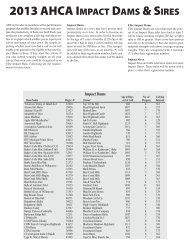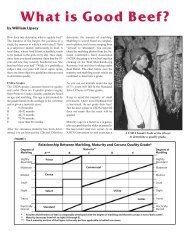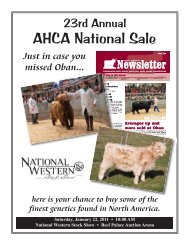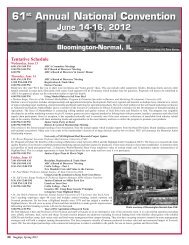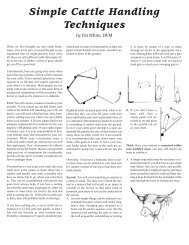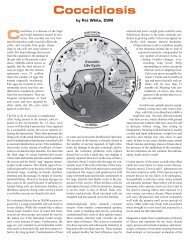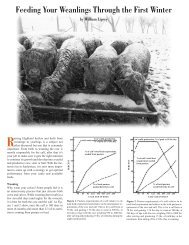The Bagpipe - American Highland Cattle Association
The Bagpipe - American Highland Cattle Association
The Bagpipe - American Highland Cattle Association
Create successful ePaper yourself
Turn your PDF publications into a flip-book with our unique Google optimized e-Paper software.
58<br />
MANAGEMENT<br />
when the big bull that normally eats 25 pounds of grain a day and drinks 3 pails of water at each feeding just plays<br />
with his water and nibbles at the grain the first day. Basically when they get thirsty they will drink and when they get<br />
hungry they will eat. On a long trip your animal can and normally will lose some weight.<br />
Animals will load best through a wide opening, especially <strong>Highland</strong>s. It is best to load through the entire width of<br />
the rear door rather than just the slide door. <strong>The</strong>y are going into a strange environment and using the slide door<br />
opening they hit their horns and really don’t load as well. This is not to say you can’t get them in a small door opening<br />
and sometimes circumstances dictate that you use it. When loading loose or haltered animals, I like to take a very slow<br />
calm approach. Hollering and shouting only makes the animal more nervous. If loading a group, try to keep them<br />
together because once one animal starts in the trailer, usually the rest follow and you want to do that as quickly as<br />
possible or the first animals in will start to come back out. If possible, always try to keep all animals headed in the same<br />
direction, sometimes easier said than done. I do not like to put feed in the trailer and coax the animals especially if<br />
there is more than one animal to load. Most of us know how <strong>Highland</strong>s are when there is feed around and the first one<br />
likes to keep the others out of the way. If loading one animal, you may try to coax it in the trailer with a pail of grain<br />
but if loading more than one loose in the same compartment, remember the one in the trailer will want to follow you<br />
out with the grain bucket.<br />
Sometimes I put hay or straw on the ground so they don’t see the step up into the trailer. If I can, I get close enough<br />
to the loading area to use the swinging door on one side and a gate or panel on the other and as the animal(s) enter the<br />
trailer, I use the door as a pusher. <strong>The</strong>re is always the possibility the animals will try to come out of the trailer in mass<br />
before you can get the door latched so make sure you have a quick and easy escape route. A 1000 pound cow hitting a<br />
six foot swinging trailer door can really knock a person end for end. It sometimes helps if the side gate or panel you use<br />
is covered with plywood so the animal cannot see daylight, they think they can go through the gate or at least try. Make<br />
sure the gate or panel is chained to the trailer or better yet, has a tractor tire against it.<br />
If an animal is at the trailer facing in and does not want to enter, I sometimes give them 1 shot with a prod (feels<br />
the same as if they touched an electric fence) and they jump forward into the trailer. All these things also apply to<br />
loading haltered animals but remember you are at the front of the animal if it decides to “leap” into the trailer. A trailer<br />
gets very small in a hurry with an upset or nervous 1200 pound cow with horns and you vying for the same space. I<br />
have loaded non-haltered animals with a lariat around their horns but I either run the rope outside through the side<br />
opening or I stand in front of a divider gate. Most animals do not like a rope just around their horns and remember, you<br />
have to get the rope off sooner or later.<br />
After loading, make sure all trailer latches are secured. I have been told it is embarrassing to arrive at your location<br />
and find the sliding door open and 1 or 2 less animals on the trailer than you started with. <strong>The</strong> sliding door in the rear<br />
will bounce to the open position if not properly latched.<br />
Each vehicle should carry a jack capable of picking up their truck or trailer with a load. Most states require that<br />
you carry DOT approved flares and a fire extinguisher. You should have a spare tire for both the trailer and the tow<br />
vehicle and the necessary tools to remove the tire. Wheels that are put on with an air wrench are sometimes very hard<br />
to get off with muscle power. A light weight 4 way spinner wrench will not always do the job. If your lugs are frozen on<br />
and you don’t have WD 40 with you, you can use a can of coke or plain old coffee to help free the rust. I carry a socket<br />
with a breaker bar plus a 2’ piece of pipe to slip over the breaker bar to break the lugs loose and this isn’t always<br />
sufficient. If nothing works, then you have to call a garage. Voice of experience speaking, don’t carry the spare for your<br />
trailer in the goose if you have a full load of <strong>Highland</strong>s.<br />
I carry a 50’ and 75’ rope that I have used in the rare cases of “wild” animals or sometimes tame animals which are<br />
spooked by unfamiliar surroundings at a show or sale. Remember, you still have to have a way to confine the animal<br />
before attempting to put the halter on. <strong>The</strong> long ropes are also sometimes handy for unloading if you can’t get the trailer<br />
to a barn, corral or wherever the customer wants the animal delivered.<br />
People think that when they are told an animal is halter broken it is easy to lead or load. Not necessarily so since<br />
many “halter broke” animals have never been lead or loaded on a trailer. <strong>The</strong>y have been brought in for weaning and a<br />
halter has been placed on them for a couple days and then they have been let loose again. If you are handling just your<br />
own animals, some of these items may appear to be irrelevant but when you go and buy from someone else, you really<br />
never know how an animal will react to strangers. Be very careful when trying to lead an unfamiliar animal. It is<br />
sometimes necessary to put a second halter or a collar on so the animal can be “stretched out” between two leaders. Do<br />
everything you can to make hauling animals as stress free on yourself and the animals as possible. I am not afraid of<br />
handling horned animals but I have a healthy respect for the size of the animals and their horns; everyone should.<br />
If after reading this you think it would be easier to hire someone to move your animals, here are a couple of thoughts<br />
I want to share with you. Most cattle haulers do not normally haul <strong>Highland</strong> cattle so make sure they know what they<br />
are going to be loading and have no problem with that. Also, normally truckers haul at the owner’s risk. Some of us do<br />
carry insurance in case of an accident on the road but if the animal slips on the trailer and injures itself, the trucker<br />
may not be willing to pay for the loss of the animal. If you have just spent megabucks for a new herd sire, you may want<br />
to look into having him insured under your policy before he is loaded on a truck. All insurance companies are different<br />
and don’t think that your farm owner’s policy will always protect you.



